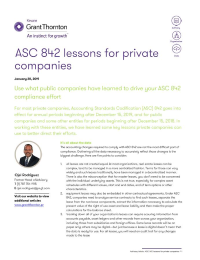-
Financial statements audits
Financial statement audits
-
Compliance audits
Compliance audits
-
Compilations and reviews
Compilations and audit
-
Agreed-upon procedures
Agreed-upon procedures
-
Tax compliance
Business Tax
-
Global mobility services
Through our global organisation of member firms, we support both companies and individuals, providing insightful solutions to minimise the tax burden for both parties.
-
Sales and use tax and indirect taxes
SUT/ VAT & indirect taxes
-
Tax incentives
Navigating the complex landscape of tax incentives in Puerto Rico can be challenging. Whether you're looking to benefit from the Export Services Act (Act 20), the Individual Investors Act (Act 22), or other incentives under Act 60, we provide tailored advice to help you maximize your tax benefits and ensure compliance. Let us help you unlock the potential of doing business in Puerto Rico.
-
Transfer Pricing
The laws surrounding transfer pricing are becoming ever more complex, as tax affairs of multinational companies are facing scrutiny from media, regulators and the public

-
Business consulting
Our business consulting services can help you improve your operational performance and productivity, adding value throughout your growth life cycle.
-
Business Risk Advisory
Risk is inevitable but manageable. We deliver relevant, timely and practical advices to aid organizations manage risk and improve business performance. We can help you identify, understand and manage potential risks to safeguard your business and comply with regulatory requirements.
-
Technology Advisory
We provide comprehensive solutions to safeguard your business and ensure operational resilience and compliance. Our expert team offers a range of technology advisory services designed to address your cybersecurity needs, enhance business continuity, and manage security effectively.
-
Transactional advisory services
Transactions are significant events in the life of a business – a successful deal that can have a lasting impact on the future shape of the organizations involved. Because the stakes are high for both buyers and sellers, experience, determination and pragmatism are required to bring deals safely through to conclusion.
-
Forensic and investigative services
At Grant Thornton, we have a wealth of knowledge in forensic services and can support you with issues such as dispute resolution, fraud and insurance claims.

Use what public companies have learned to drive your ASC 842 compliance effort
For most private companies, Accounting Standards Codification (ASC) 842 goes into effect for annual periods beginning after December 15, 2019, and for public companies and some other entities for periods beginning after December 15, 2018. In working with these entities, we have learned some key lessons private companies can use to better direct their efforts.
It’s all about the data
The accounting changes required to comply with ASC 842 are not the most difficult part of compliance. Gathering all the data necessary to accurately reflect those changes is the biggest challenge. Here are five points to consider:
- all leases are not created equal. At most organizations, real estate leases can be complex, tend to be managed in a more centralized fashion. Terms for those can vary widely and such leases traditionally have been managed in a decentralized manner. There is also the misconception that for master leases, you don’t need to be concerned with the individual underlying assets. This is not true, especially for complex asset schedules with different values, start and end dates, end of term options or other characteristics.
- equipment leases may also be embedded in other contractual agreements. Under ASC 842, companies need to analyze service contracts to find such leases, separate the lease from the non-lease components, extract the information necessary to calculate the present value of the right of use asset and lease liability and then make the proper calculations for the balance sheet.
- tracking down all of your organization’s leases can require scouring information from accounts payable, asset ledgers and other records from across your organization, including those from subsidiaries and foreign offices. Some lease records will be on paper only; others may be digital—but just because a lease is digital doesn’t mean that the data is ready for use. For all leases, you will need an audit trail for any changes made to the lease
- for international organizations, leases may need to be translated from foreign languages. Foreign leases documents may be structured differently and use different terms. They also may be denominated in foreign currencies, which will require conversion.
- not only do you need to reach across geographical boundaries and down into subsidiaries, your lease accounting effort should also cross functional boundaries. Real estate and legal are obviously involved, but as you consider and address how various leasing terms will affect you not just now but going forward, you’ll want to educate procurement and IT and other operational groups, including facilities, office management.
Software helps, but it has limits
Most organizations are implementing software designed specifically to address the new challenges presented by ASC 842. This marks a change at many companies, as most organizations have traditionally managed lease data through spreadsheets. Unfortunately, those spreadsheets have tended to be decentralized. Often each subsidiary maintained its own leasing records. In addition to decentralization, which makes it more difficult to track down your entire lease population, spreadsheets require constant manual updating, which increases the risk of errors. They also aren’t set up to perform the calculations that will be necessary to post your lease data to the balance sheet.
As mentioned previously, real estate leases have tended to be tracked separately from other leases. Many organizations with large real estate portfolios use software for lease administration. While they often have lease data, much of it primarily operational in nature, meaning the information required for transition adjustment calculations is incomplete or inconsistent with the contract documentation.
ASC 842’s silver lining—better lease management
Until now, most organizations have not followed uniform practices for requesting, initiating, tracking and managing leases. Now, with leases reported on the balance sheet, that has to change. The tools and processes you develop to comply with the standard don’t just need to work through the transition, they have to support your lease accounting going forward. This provides real opportunities to improve your leasing and lease management processes. Opportunities for improvement?
- centralizing lease data may also allow you to better centralize leasing decisions. Having all the data in one place can drive better lease versus buy decisions, and could give you leverage to gain better terms from your lessors.
- standardize your lease negotiation, approval and management practices, controls and technology to be more consistent with capital request and other spend categories.
- better align the negotiation of your leases with your business objectives
- analyze your lease portfolio to evaluate rates, determine risks associated with lessor concentration, ensure timely action on expired or about-to-expire leases, and manage other issues.]
Most public companies have found that meeting the ASC 842 challenge has taken more time and effort than they anticipated. Private companies should learn from their experience and start there ASC 842 efforts in earnest now.
We have deep experience with ASC 842, and we are ready to help you.

